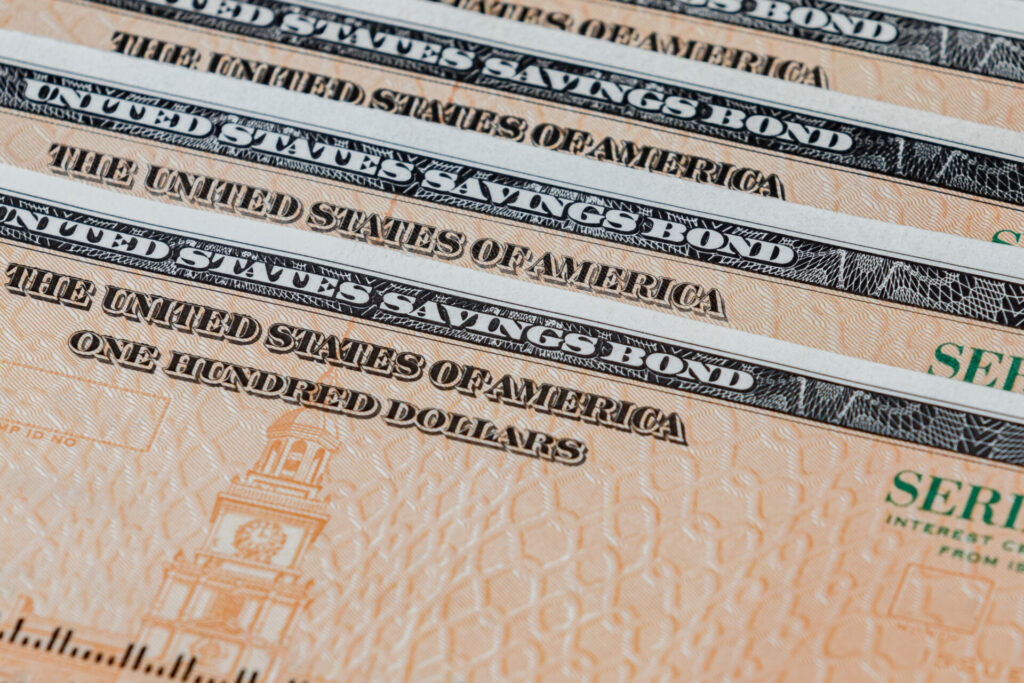U.S. savings bonds are a popular choice for investors looking for a secure and steady return on their investments. They are backed by the government, which ensures both the safety of your principal and a guaranteed return. As a low-risk investment, savings bonds can contribute to achieving your long-term financial goals, such as retirement savings or educational expenses.
Key Takeaways
- You can check the current value of your U.S. savings bonds online via the U.S. Treasury’s TreasuryDirect website.
- There are two main types of U.S. savings bonds, Series I and Series EE. Both are low-risk investments but come with distinct features.
- You can cash in U.S. savings bonds at most financial institutions or electronically through TreasuryDirect.
What Are U.S. Savings Bonds?
When you buy a savings bond, you are lending money to the U.S. government in return for interest over time. These bonds are backed by the U.S. government, making them virtually risk-free from default.
Savings bonds earn interest that is typically compounded semiannually. The interest rate depends on the type of bond you buy and when it was issued. You can earn interest on savings bonds for up to 30 years.
The long-term nature and predictable returns make savings bonds a stable component of many investment portfolios, especially for goals such as education savings, retirement or other long-term financial planning.
Types of Savings Bonds
The U.S. Department of the Treasury currently issues two main types of savings bonds: Series EE and Series I bonds. Both types are low-risk investment options, but they have distinct features and benefits.
Series EE Bonds
You can purchase Series EE bonds in electronic form through the TreasuryDirect website, making them easily accessible to the public.
The interest on an EE bond is added monthly and compounded semiannually, ensuring the bond’s value grows predictably over time. A unique feature of EE bonds issued after May 2005 is that they are guaranteed to double in value if held for 20 years, effectively setting a minimum interest rate. This guarantee makes them a safe investment option for long-term savings goals.
Series I Bonds
You can purchase Series I bonds in both electronic and paper form — you can even purchase paper Series I bonds with your IRS tax refund. Similar to EE bonds, they are available through TreasuryDirect.
The interest on Series I bonds consists of a fixed rate that stays the same for the life of the bond plus an adjustable rate based on inflation, recalculated every six months. This makes Series I bonds an attractive option if you are concerned about inflation eroding your savings.
You can redeem your Series I bond after 12 months, but cashing in before five years makes you lose the previous three months’ worth of interest. You can continue earning interest on your Series I bond for up to 30 years.
>> Related: How Do Savings Bonds Work?
How To Check the Value of U.S. Savings Bonds
Understanding the current value of your U.S. savings bonds is essential for effective financial planning and investment management. Luckily, the U.S. Treasury offers tools to help you calculate the value of your bonds online.
What You’ll Need
To accurately determine the value of your savings bond, you’ll need the following information:
- Type of bond (Series EE or Series I)
- Denomination (the face value of the bond)
- Serial number (found on the paper bond)
- Issue date (the month and year you purchased the bond)
Calculating the Value of Paper Bonds
If you are holding paper bonds, the TreasuryDirect website provides a Savings Bond Calculator that allows you to determine the current value. Here’s how to use it:
- Visit the TreasuryDirect website and navigate to the “Tools” section, where you’ll find the Savings Bond Calculator.
- Enter the required information for each bond such as the series, denomination, serial number and issue date.
- The calculator will display the bond’s current value, including interest earned to date.
This tool is also valuable for estimating future values, which can aid in financial planning. The TreasuryDirect website offers additional resources and guides, including material to help you understand how interest rates affect bond values and how to plan for tax implications.
Calculating the Value of Electronic Bonds
If your bonds are held electronically in a TreasuryDirect account, checking their value is even more straightforward:
- Log in to your TreasuryDirect account.
- Navigate to the section of your account where your bonds are listed. This is typically under “My Account” > “Holdings.”
- Here, you will see a detailed list of your bonds including their type, issue date and current value.
TreasuryDirect automatically updates the value of your electronic bonds, reflecting accrued interest and current worth. This feature makes it easy to monitor the performance of your investment and to make informed decisions about holding or redeeming your bonds.
Cashing in Savings Bonds
Cashing in U.S. savings bonds is a straightforward process whether you hold paper bonds or electronic versions.
Cashing In Paper Bonds
To redeem paper savings bonds, follow these steps:
- Visit a financial institution: You will need to bring your paper bonds and valid identification.
- Present the bonds to a teller: The teller will verify the bonds’ authenticity and ensure that they have matured or are eligible for redemption.
- Process the transaction: The teller will redeem the bonds and deposit the funds directly into your account or give you a check.
It’s important to note that while most banks and credit unions offer this service, some may have specific policies or limits on the amount that you can redeem at one time. Therefore, checking with your institution before attempting to cash in significant amounts is advisable.
Cashing In Electronic Bonds
You can redeem electronic savings bonds, held through TreasuryDirect, online. To cash in electronic bonds, follow these steps:
- Log in to your TreasuryDirect account.
- Navigate to the “ManageDirect” section.
- Select the bonds you wish to redeem and specify the amount.
You can have the redemption amount credited directly to your checking or savings account, including those held at institutions like Navy Federal. The process is typically fast, with funds usually available within one to two business days.
Considerations Before Cashing In
Cashing in U.S. savings bonds at the right time is crucial to maximizing your investment’s return. These bonds are long-term investments, with features that reward you for keeping them until maturity and the potential loss of some earned interest with early withdrawal.
Amount of Return
Series EE bonds are guaranteed to double in value if you hold them for 20 years. Similarly, the interest rate for Series I bonds, which adjusts for inflation, can make them more valuable over time, especially in high-inflation environments.
Review the current and historical interest rates of your bonds, considering the broader economic context, such as inflation trends, to make an informed decision about the timing of redemption.
Tax Implications
The decision to cash in your savings bonds also has tax implications. The interest earned on U.S. savings bonds is subject to federal income tax, but it is exempt from state and local taxes. Importantly, if you use the interest from Series EE or I bonds to pay for qualified educational expenses, you may be eligible for a tax exemption, subject to certain conditions and income limits.
Timing your bond redemption to coincide with these expenses can provide additional financial benefits. Before redeeming your bonds, you may want to consult with a tax advisor to understand the potential tax impact and explore strategies for minimizing your liability, such as staggering redemptions across tax years to lower your overall tax burden.
Penalties
For bonds cashed in before five years, you’ll lose the last three months of interest. Balancing the need for immediate cash against the potential growth of your bonds is a key part of managing your savings effectively.
The Bottom Line
Series EE and Series I savings bonds represent secure and flexible options if you are looking to support your long-term financial goals. No matter what significant financial milestones you’re aiming for, understanding the timing, tax implications and potential growth of your savings bonds can significantly impact your financial planning.
FAQ: U.S. Savings Bonds Value
Can I cash in my savings bond before it matures?
Yes, you can cash in your savings bond before it matures. However, if you redeem within the first five years after issuance, you may forfeit interest earned during the three months before redemption.
Are there any tax implications when cashing in savings bonds?
When you cash in your savings bonds, the interest earned is subject to federal income tax but exempt from state and local taxes. You can defer paying taxes until you redeem the bond or until it reaches its maturity date.
How can I maximize the value of my savings bonds?
To maximize the value of your savings bonds, consider holding them until they reach their maturity date to benefit from all the possible earned interest. Additionally, understanding the different rates and rules for each type of bond can help optimize their value.
Editor’s Note: Before making significant financial decisions, consider reviewing your options with someone you trust, such as a financial adviser, credit counselor or financial professional, since every person’s situation and needs are different.





